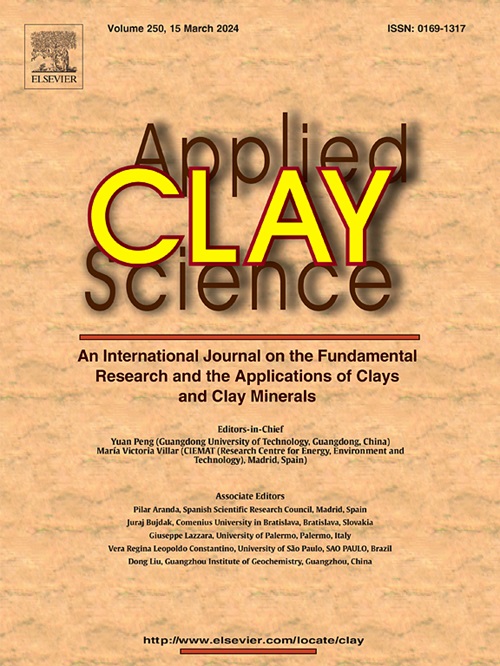BCV 2017 膨润土在 200 °C 空气中长期加热时层间离子固定的可逆性,一项详细的矿物学研究
IF 5.8
2区 地球科学
Q2 CHEMISTRY, PHYSICAL
引用次数: 0
摘要
在与处置发热废物相关的研究中,本研究旨在描述 BCV 2017 Ca-Mg 膨润土(捷克共和国 Černý vrch 膨润土)在 200 °C 空气中短时间(1 天)和长期(47 个月)加热后发生的矿物学转变。在原始膨润土中,有两个富含闪长岩的混合层矿物模型,由 10 埃的高电荷和低电荷闪长岩层组成。10 埃层既代表伊利石层,也代表层间有固定 Mg2+ 和 Ca2+ 离子的直闪石层。在 200 °C 下加热 47 个月后,总阳离子交换容量(CEC)从 58 meq/100 g 下降到 48 meq/100 g,可交换 Ca2+ 的含量从 25 meq/100 g 增加到 27 meq/100 g,可交换 Mg2+ 的含量从 47 meq/100 g 下降到 27 meq/100 g。由于层间 Mg2+ 的固定比 Ca2+ 的释放更重要,因此观察到 CEC 下降。伴随着这种下降,层间固定 Mg2+ 的直闪石层(10 Å 层)的数量从 12% 增加到 19%(两个富含直闪石的 MLM 的平均值),低电荷直闪石层的数量从 67% 增加到 76%。同时观察到高荷电荷的闪长岩层数从 22% 减少到 5%。加热 1 天的 BCV 2017 膨润土达到了原始膨润土和加热 47 个月膨润土之间的中间值。层间 Mg2+ 的固定具有部分可逆性,在相对湿度为 97.6 % 的条件下复水 54 天后,Mg2+ 从 27 meq/100 g 增加到 31 meq/100 g。10Å 层在 MLMs 中的比例从 19% 降至 16%,CEC 从 48 meq/100 g 增至 52 meq/100 g。在相同的时间段内,用固液比为 1:100 的液态水对加热后的膨润土进行饱和处理,也得到了类似的结果。本文章由计算机程序翻译,如有差异,请以英文原文为准。
The reversibility of interlayer ion fixation in the smectite of BCV 2017 bentonite during long-term heating in air at 200 °C, a detailed mineralogical study
In the context of studies related to the disposal of heat-generating wastes, the aim of this study was to characterize the mineralogical transformations that take place in the BCV 2017 Ca-Mg bentonite (Černý vrch bentonite, Czech Republic) following short (1-day) and long-term (47-month) heating in air at 200 °C. A laboratory procedure involving interlayer cation exchange using the Cu-trien complex with subsequent ethylene glycol solvation and full-profile diffraction pattern modelling was successfully applied for the comparison of the original bentonite and the material heated at 200 °C in air, as well as their subsequent rehydration.
In the original bentonite, two smectite-rich mixed layers minerals were modelled, consisting of 10-Å, high- and low-charge smectite layers. The 10-Å layers represented both the illite and also smectite layers with fixed Mg2+ and Ca2+ ions in the interlayer. After heating at 200 °C for 47 months, the total cation exchange capacity (CEC) decreased from 58 to 48 meq/100 g, the content of exchangeable Ca2+ increased from 25 to 27 meq/100 g, and the content of exchangeable Mg2+ decreased from 47 to 27 meq/100 g. The increase of exchangeable Ca2+ was caused by liberation of originally fixed Ca2+ in the interlayer of smectite while decrease of exchangeable Mg2+ was due to its fixation. The predominance of the fixation of interlayered Mg2+ over the liberation of Ca2+ led to the observed decrease of CEC. This decrease was accompanied by increase in the number of both smectite layers with interlayer-fixed Mg2+ (10-Å layers) from 12 to 19 % (an average value of two smectite-rich MLMs), and low-charged smectite layers from 67 to 76 % in MLMs. A simultaneous decrease in the number of high-charged smectite layers from 22 to 5 % was observed. The BCV 2017 bentonite heated for 1-day reached intermediate values between the original and 47-month heated bentonites.
The fixation of the interlayered Mg2+ was partially reversible, increasing from 27 to 31 meq/100 g after rehydration for 54 days under relative humidity of 97.6 %. The percentage of the 10-Å layers decreased from 19 to 16 % of MLMs and the CEC increased from 48 to 52 meq/100 g. Similar results were obtained when the heated bentonite was saturated with liquid water with 1:100 solid:liquid ratio for the same time period.
求助全文
通过发布文献求助,成功后即可免费获取论文全文。
去求助
来源期刊

Applied Clay Science
地学-矿物学
CiteScore
10.30
自引率
10.70%
发文量
289
审稿时长
39 days
期刊介绍:
Applied Clay Science aims to be an international journal attracting high quality scientific papers on clays and clay minerals, including research papers, reviews, and technical notes. The journal covers typical subjects of Fundamental and Applied Clay Science such as:
• Synthesis and purification
• Structural, crystallographic and mineralogical properties of clays and clay minerals
• Thermal properties of clays and clay minerals
• Physico-chemical properties including i) surface and interface properties; ii) thermodynamic properties; iii) mechanical properties
• Interaction with water, with polar and apolar molecules
• Colloidal properties and rheology
• Adsorption, Intercalation, Ionic exchange
• Genesis and deposits of clay minerals
• Geology and geochemistry of clays
• Modification of clays and clay minerals properties by thermal and physical treatments
• Modification by chemical treatments with organic and inorganic molecules(organoclays, pillared clays)
• Modification by biological microorganisms. etc...
 求助内容:
求助内容: 应助结果提醒方式:
应助结果提醒方式:


